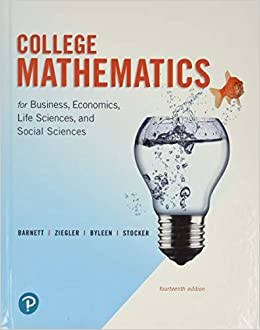Question
3. (Bond valuation) A bond that matures in 19 years has a $1,000 par value. The annual coupon interest rate is 14 percent and the
3.(Bond valuation) A bond that matures in 19 years has a $1,000 par value. The annual coupon interest rate is 14 percent and the market's required yield to maturity on a comparable-risk bond is 17 percent. What would be the value of this bond if it paid interest annually? What would be the value of this bond if it paid interestsemiannually?
a.The value of this bond if it paid interest annually would be $ . (Round to the nearest cent.)
4.(Bond valuation)Pybus, Inc. is considering issuing bonds that will mature in 24 years with an annual coupon rate of 9 percent. Their par value will be $1,000, and the interest will be paid semiannually. Pybus is hoping to get a AA rating on its bonds and, if it does, the yield to maturity on similar AA bonds is 10 percent. However, Pybus is not sure whether the new bonds will receive a AA rating. If they receive an A rating, the yield to maturity on similar A bonds is 11 percent. What will be the price of these bonds if they receive either an A or a AA rating?
a. The price of the Pybus bonds if they receive a AA rating will be $ . (Round to the nearest cent.)
5.A bond's market price is $1,100. It has a $1,000 par value, will mature in 6 years, and has a coupon interest rate of 11 percent annual interest, but makes its interest payments semiannually. What is the bond's yield tomaturity? What happens to the bond's yield to maturity if the bond matures in 12 years? What if it matures in 3 years?
a.The bond's yield to maturity if it matures in 6 years is %. (Round to two decimal places.)
6.Fitzgerald's 25-year bonds pay 11 percent interest annually on a $1,000 par value. If the bonds sell at $895, what is the bond's yield to maturity? What would be the yield to maturity if the bonds paid interest semiannually? Explain the difference.
a. The bond's yield to maturity if the bond pays interest annually is %. (Round to three decimal places.)
7.(Bond valuation) Doisneau 24-year bonds have an annual coupon interest of 15 percent, make interest payments on a semiannual basis, and have a $1,000 par value. If the bonds are trading with a market's required yield to maturity of
17 percent, are these premium or discount bonds? Explain your answer. What is the price of the bonds?
a. If the bonds are trading with a yield to maturity of 17%, then (Select the best choice below.)
Step by Step Solution
There are 3 Steps involved in it
Step: 1

Get Instant Access to Expert-Tailored Solutions
See step-by-step solutions with expert insights and AI powered tools for academic success
Step: 2

Step: 3

Ace Your Homework with AI
Get the answers you need in no time with our AI-driven, step-by-step assistance
Get Started


